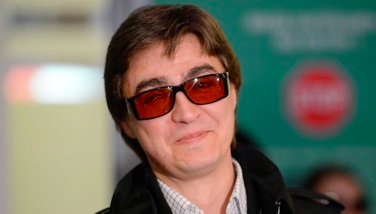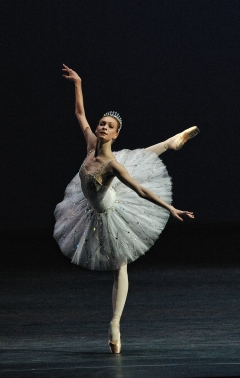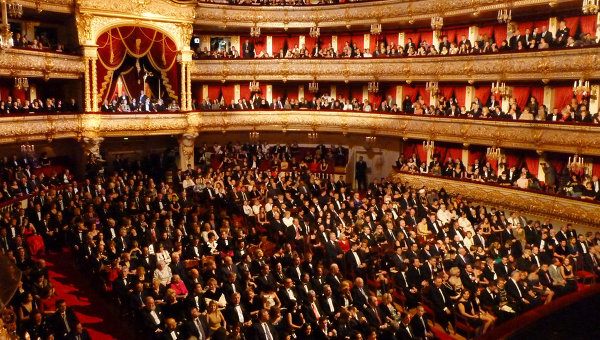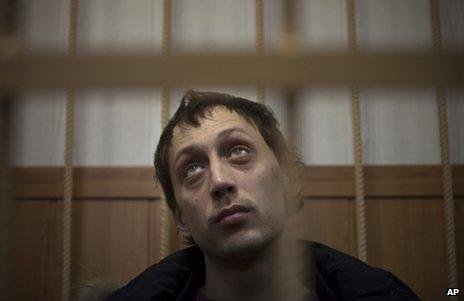Money, love, professional jealousy - the three undying motives for personal crime, and all three were present in the Bolshoi Ballet acid trial. An international public that scoffed happily at the OTT ballet horror-show that was the film Black Swan was suddenly sobered up by real-life events that needed no cinematographers and screenwriters. A dancer had commissioned a criminal with a murder conviction to seriously hurt his boss, the artistic director of the great Bolshoi Ballet, Russia’s most glamorous, skilled and commercially desirable cultural export, and the boss was now scarred and near-blind.
Yesterday that dancer, Pavel Dmitrichenko, was convicted of GBH and locked up for six years in a high-security jail, the sort of place where his obvious naivety and undisciplined temper will not serve him well. His calculating hitman, Yuri Zarutsky, who chose to use sulphuric acid for the attack, was sentenced to 10 years in a maximum-security hard-labour colony, due - as the judge said - to his ready recidivism to violent behaviour. Zarutsky’s driver, Andrei Lipatov, the little guy who got swept up into the big guys' scheme, was jailed for four years, also in high-security conditions, which seems unnecessarily harsh.
 The one with the even longer sentence, with even harder labour ahead, is the victim, Sergei Filin, the Bolshoi Ballet artistic director (pictured right, by RIA Novosti), who by legal definition of GBH is now a long way below capable of doing his demanding job, and thereby, without surgical miracles, is doomed before long.
The one with the even longer sentence, with even harder labour ahead, is the victim, Sergei Filin, the Bolshoi Ballet artistic director (pictured right, by RIA Novosti), who by legal definition of GBH is now a long way below capable of doing his demanding job, and thereby, without surgical miracles, is doomed before long.
What the trial mercilessly peeled away was that under its smiling touring face, the Bolshoi Ballet was operating on borrowed time, on exploitative old labour practices that have no place in a judicially-driven modern world. It also exposed a quite staggering capacity for cynicism in the general Russian public - a deep disinclination to believe that artists who entertain them are any different from gangsters, and an ingrained mistrust of police and justice.
I felt more and more as if I were watching a nightmare that Lewis Carroll and Franz Kafka were co-writing
Covering events over the past year, from the attack last January to the trial's conclusion yesterday, I felt more and more as if I were watching a nightmare that Lewis Carroll and Franz Kafka were co-writing. How low could people sink? Dancers leapt to the trial to fire mud and slander at others. Lawyers fashioned tortuous lines of defence involving conspiracies between nations. Police apparently got away with whatever they liked, thanks to a judge's compliance.
Worst, speaking as a journalist, I found the behaviour of most of the Russian press reprehensible. I may be accused of being naive to say so, in that country's context, but the press is the one profession that exists to tell things as they are, and therefore speak to the public about the systems they live within and help them maintain the power to judge and trust their authorities. But in Russia there would appear still to be no systemic understanding of the need for honest, objective factual law reporting. Papers and TV channels revealed themselves repeatedly as vessels for one or the other side, cherrypicking bits of the case, looking for the parts that fed their prejudice - not seeing the press's greater need to relate to the public how justice was being done. While I noted some commentators wished this had been a European-type jury trial, not simply a hearing before a judge with a 99 per cent conviction record, no jury could possibly have been uninfluenced by such selective, opinion-driven coverage, in print or online.
Hence, my impression was that few people involved in this cacophonous case, on either side, within the Bolshoi or out, had much interest in sober judgement of right and wrong. Culture politicos were as guilty as anyone of striking attitudes, rather than taking responsible positions. Yet without that basic floor being put down, that statement of the desire for sober responsibility - which I consider the press had the duty to supply - gossip, smears and prejudice will continue to be the stuff of so-called justice. All I could see in this trial was a long string of obvious malpractices, inevitably leading step by step to disaster.
Inside the Bolshoi, competition has been contorted into a malicious Darwinian battle to be noticed, by any means
I hope with all my heart that those powerplayers who circle like vultures around the Bolshoi Ballet can see that this entire case has been an unmitigated disaster for Russia, but that it offers opportunities for redemption and rethinking. Not least, that they should only employ the number of dancers they can properly employ, which means no cynical over-staffing just to show it's the biggest. While competition is healthy in a proper environment, the trial uncovered that inside the Bolshoi competition has been contorted into a malicious Darwinian battle to be noticed, by any means.
In the corps de ballet you are one girl in 100 or more; you are paid a pittance, and only by being spotted and cast regularly as one of the 32 swan-girls in Swan Lake or a snowflake in The Nutcracker can you hope to start making a living. To win a tiny solo could even be a career breakthrough, but at least it will bring you a cash bonus.
But what if you are one of the unwanted corps de ballet? The dancers who are bidden to daily class, to go through motions of a swangirl or tentatively practise a solo, and yet never find your name on the printout of the lucky bunch, day after day, week after week? What if you are a highly-ranked dancer whom the present director doesn't like? What if you become depressed, bitter, wretched?
This is where corruptibility breeds. During the trial Dmitrichenko accused Filin of using a casting couch, and last month an American teenager who had been recruited into the Bolshoi, Joy Womack, told something equally dismaying in her news-making departure not long after. She said she was told that she should find herself a rich patron, to buy her some opportunities.
 Filin sharply rejected the casting couch charge, and indeed the example Dmitrichenko pointed at to illustrate his allegation was improbable - he instanced the rising young ballerina Olga Smirnova, when it has been instantly obvious to British critics this summer, on seeing her, that this is an artist who needs nothing more than her exceptional talent to travel to stardom (Smirnova pictured left in Diamonds, by Marc Haegemann/Bolshoi).
Filin sharply rejected the casting couch charge, and indeed the example Dmitrichenko pointed at to illustrate his allegation was improbable - he instanced the rising young ballerina Olga Smirnova, when it has been instantly obvious to British critics this summer, on seeing her, that this is an artist who needs nothing more than her exceptional talent to travel to stardom (Smirnova pictured left in Diamonds, by Marc Haegemann/Bolshoi).
The casting couch has form in Russian ballet, and in other countries' ballet too. But the 21st-century Bolshoi had seemed to be addressing major changes with a will. In post-Soviet Russia, ballet faced a turbulent period of catching up, its creativity a long way behind the busy, vigorous West and its management systems suddenly very exposed in the light of world practice, where industrial tribunals clean up labour inequalities (supposedly), and unions guard pay grades.
It was his success in addressing both problems Russian-style that made Anatoly Iksanov a highly regarded general director at the Bolshoi Theatre, from many viewpoints. A man of exceptional theatre management intelligence and political independence, he became chief in 2000 but was told by the government to fall on his sword this summer, as part of the fall-out from this poisonous case.
Iksanov was caught between old-Russian and new-Russian perceptions. The old Russia hangs on from the Soviet era, disliked the western “others”, Europe, the States. The new Russia has recognised that it was not superior in every last thing, and virtue lay in being open to learning from others.
Iksanov admired the commercial advantages and artistic sophistication of Western ballet practice and audiences. He set up a Bolshoi fundraising board, private patronage, hugely boosted touring profile. He appointed opera and ballet directors who sensed that the Bolshoi was located no longer inside Russian ramparts, but in an open international world.
He appointed Sergei Filin, a top Bolshoi dancer, to direct the Bolshoi Ballet, two years ago.
Dmitrichenko, like the notoriously self-dramatising Nikolai Tsiskaridze, did not accept or respect the appointment. In part, Filin was too close in age. He was a mere 12 years older than Dmitrichenko, he was handsome, he had always taken the prince roles, while Dmitrichenko’s features resigned him to villainy.
Filin was, however, the same generation as Tsiskaridze, who believed he himself was a more fabulous ballet prince and deserved Filin’s job better - he had already made life miserable for a previous director, Alexei Ratmansky.
Ratmansky’s five years running the Bolshoi Ballet in the mid-Noughties, may come, in future, to seem a brief golden age - a marvellous array of young stars emerged in mildly adventurous, disproportionately stimulating choreographic repertoire. However, this new life was happening on the secondary smaller theatre, the “New Stage”, while the grand “Main Stage” theatre - the scene of many an iconic Bolshevik Revolution orator - was being renovated. Could this open-doors approach be transplanted into the factory vastness of the Main Stage?
As the reopening of the leviathan of Russian theatre approached, the politicians and ministers and the public’s ballet idols honed their patriotic rhetoric for the landmark occasion. The rhetoric invoked the great, certain days of Soviet glory on the stage - when big ballets were staged, Bolshoi-sized ballets. Those who looked westward for new nourishment and more varied options started having to look over their shoulder. It was back to the warhorses.
Ratmansky resigned months before the reopening, half pushed, half eager to fly away to where he would not be made to feel as if his only very slightly innovative artistic decisions were cultural treason. He had also had more than enough of being openly contemned in the Bolshoi corridors by Nikolai Tsiskaridze, who revelled in his own personality cult and who adds to a slavish public following the more important support of some extremely high-up political women, married to Putin’s inner circle of ministers and industrialist friends.
 When the Bolshoi Theatre reopened, Iksanov became the ultra-conservatives’ whipping boy for the corruption and garishness of some of the enterprise. (Though it was not his fault. After all, it was a political project, designed to reproduce the Soviet-era Bolshoi.) Tsiskaridze played the nationalist card to powerful effect: the “new” Bolshoi Theatre was paste, bling, impure - which was code for: "and so are its modern ways", such as Western choreographers and the occlusion of native superstars such as himself. (It is relevant that Russia's lack of choreographers has generated a ballet culture that is stars-led, where in the West it has become choreographers-led.)
When the Bolshoi Theatre reopened, Iksanov became the ultra-conservatives’ whipping boy for the corruption and garishness of some of the enterprise. (Though it was not his fault. After all, it was a political project, designed to reproduce the Soviet-era Bolshoi.) Tsiskaridze played the nationalist card to powerful effect: the “new” Bolshoi Theatre was paste, bling, impure - which was code for: "and so are its modern ways", such as Western choreographers and the occlusion of native superstars such as himself. (It is relevant that Russia's lack of choreographers has generated a ballet culture that is stars-led, where in the West it has become choreographers-led.)
To find a successor capable of satisfying the gnawing hunger for Bolshoi-sized Russian self-esteem therapy, as well as capable of continuing the artistically lively, financially blossoming progress of the revived Bolshoi Ballet on foreign tours, was Iksanov’s biggest job. One potential candidate, the company manager Gennady Yanin, was given the classic Soviet-era kompromat heave-ho - sexually explicit pictures of him were splashed over the internet, gay pictures of a married man. Who was behind that remains unsolved.
Filin himself would fall foul of internet trollery, just before the acid attack last January. But he was a bright choice in 2011. A big star in Ratmansky’s period, open to the West and the interesting evolutions in world ballet, but also personally at ease with the elderly, omnipotent Yuri Grigorovich. And he was supposedly one of the boys. A fresh, modern choice for a fresh, modern Bolshoi.
However, when you’re artistic director you do have to make choices; and Filin’s decisive promotions and invitations to dancers from other theatres to join the Bolshoi raised, naturally, the corrosive whisper of favouritism. His authority proved as unstable as that of Ratmansky, or indeed any of the five other artistic directors who have come after the iron-clad Soviet boss Grigorovich.
For his likes and dislikes affected dancers' ability to survive on their salaries. While most companies award pay openly on rank, the Bolshoi’s obscure payments system remained unreformed, and, in austere modern times, was acting like vitriol on company morale. Dancers who had done well in certain repertoire, such as Grigorovich’s (he had casting authority), found themselves the poorer when Ratmansky, who was keen to renovate classics monopolised by Grigorovich’s productions, raised an alternative team of stars for his productions. Cue gnashing of teeth and appeals to outside agencies, tame press publications, tame politicos, all to undermine the artistic directorship. The increasing financial need for high-paying foreign ballet students in Russia’s top ballet schools also increased the competition, and the xenophobia.
In corps de ballet classes morale was low and they didn’t try. Filin went into a Giselle rehearsal, saw how they were dancing, and berated them, telling them circus freaks could dance better. He told them if they didn’t get to daily class he would fine them. Dmitrichenko yelled expletives right back at him, and thus a hero of the underclass was born.
In a world of competitiveness, ill-discipline, favouritism and a wholly opaque salary system, representation of the workers was badly needed. Dmitrichenko, hot-tempered and rash, but protected by his closeness to Grigorovich, stood in for another dancer 12 months ago on the regular quarterly “grants” committee, which decided on the bonuses each dancer would get on top of their pittance. That meeting, usually 3 hours long, lasted 10 - it played an ominous part in the horrific event a month later.
Headed by Filin, the committee traditionally deferred to his wishes. Filin’s system was little different from that at the Mariinsky Ballet up in St Petersburg, loathed by dancers, dating back to Soviet times. It awarded bonuses to dancers for performance, according to a time-honoured ranking of what a solo was worth. But dancers not chosen to perform did not qualify. Dmitrichenko, petitioned by the timorous corps de ballet to represent their interests, unceremoniously commanded that all dancers, whether chosen to perform or not, were doing their work as required, and therefore should be entitled to some of the quarterly bonus pot.
Unexpectedly, the rest of the committee agreed with him, against Filin, who was furious. The archaic system depended on sticks as well as carrots, and he was dissatisfied with the slack attitude of many dancers, who would drift off to do other things or claim sick leave without any notice. Paying dancers more whom he did not think worth showing on stage was not appealing, when it reduced his favours to the dancers he did wish to show.
It was a strange liaison: the burly ex-con who had committed murder and the dancer who danced the villain roles
By now Dmitrichenko's hatred of his boss had hardened into a plan. A year earlier the soloist, who had a side interest in developing a dacha cooperative outside Moscow for Bolshoi dancers, had met a man who claimed he could get him building materials and supplies at unofficial rates. His name was Yuri Zarutsky, and they became friendly. It was a strange liaison: the burly ex-con who had beaten a man to death and the dancer who danced the villain roles in ballets (the Mouse King in Nutcracker, Rothbart in Swan Lake, and Grigorovich’s anti-heroes). Yet Dmitrichenko started confiding in Zarutsky about his loathing for Filin.
This was not initially due to any what-about-the-workers altruism. Far closer to Dmitrichenko’s heart was his longtime girlfriend, Angelina Vorontsova, a porcelain-pretty blonde ballerina for whom Dmitrichenko had abandoned his first wife. Young Vorontsova was talented and ambitious; she wanted to dance the leading role in Swan Lake, the iconic ballerina role, but Filin told her she was not ready, physically or stylistically.
Besides, he said pointedly, she needed a different coach, a woman. And Vorontsova was one of the very few pupils of Filin’s arch-foe Tsiskaridze.
Dmitrichenko took double-umbrage at this. He was already pro-Tsiskaridze, being like him a Grigorovich favourite, and also because Tsiskaridze was highly complimentary of Vorontsova. And he naturally believed his love deserved top billing, while he eyed askance the rising trajectory of her contemporary, Olga Smirnova. One of the mightiest shames of this dreadful case is the shadow that Dmitrichenko’s and Tsiskaridze’s supporters continue to try to cast over the wonderful Smirnova, whom Filin, showing an acute eye for talent, snapped up from under the Mariinsky Ballet’s eye when she was leaving school.
In fact, he had, in his previous job, also given Dmitrichenko’s charming Vorontsova a boost when she was still at school, sponsoring her move to Moscow’s academy. But then she had finessed Filin by moving rapidly on to the Bolshoi, when Filin intended to hire her for his own company (at the time), the secondary, much smaller Stanislavsky.
Both the suspicious Dmitrichenko and the more naive Vorontsova imagined that when Filin himself came to head the Bolshoi, the decline in Filin’s interest in her had to be about payback for the snub. But testimony in court and statements outside by the Bolshoi’s eminent senior ballet mistress Marina Kondratieva explained that Vorontsova, like many young ballerinas in the Bolshoi, expected too much too soon in an exceptionally tough world, where very few could shine. The now famous-for-the-wrong-reasons Vorontsova shines at the less demanding Mikhailovsky Ballet, where they take the Oscar Wilde view that it is far better to be talked about than not to be.
Scandal and mudslinging became the substance of much of this unedifying trial
But scandal and mudslinging became the main substance of much of this unedifying trial, almost drowning the hard facts of the crime. Dmitrichenko’s team tried two lines of defence; during the summer, before the trial, his first lawyer whipped up Tsiskaridze’s publicly expressed scepticism about the genuineness of damage to Filin’s eyesight, suggesting that all foreign doctors must be liars and in cahoots with the Moscow police and Bolshoi Theatre in this fantasy to ensure Tsiskaridze was fired. For this accusation, repeated more than once in TV interviews, Tsiskaridze was issued first with official reprimands by the Bolshoi, and then, in June, with dismissal.
It’s being said that Dmitrichenko himself hated this defence line and replaced his lawyer. His second took an equally ad hominem line, occupying himself largely with whipping up hearsay accusations about Filin’s unfair methods and exploitative relations with female dancers. The net effect - as some commentators sadly noted - was as if to argue that Filin deserved to be violently beaten up, even blinded by acid, that this was a suitable and acceptable response in today’s Russia by an employee who did not like his boss.
So yet another victim emerged, to add to the trail of ruined lives and muddied futures - the Russian justice system itself. One of the noticeable features has been the widespread and deep mistrust howled by Dmitrichenko supporters against the Moscow police, and the failure of this high-profile trial to see this as a serious point of public faith and deal with it via the evidence. Dmitrichenko and another dancer both claimed police beat them into confessions of some kind; Dmitrichenko said it was on video, but attempts to play the crucial video were prevented by technical incompetence.
As a result of this half-heartedness in ascertaining the integrity of police evidence, the verdict itself is being held up by many with incredulity. Judge Elena Maximova is noted for her unwavering conviction rate for every suspect the police bring before her. Ergo, her verdicts and police investigations - say some - have not the slightest veracity. Ergo, Dmitrichenko is innocent. Even though he concedes he is not, his legions of fans argue, as if from mythic necessity, that the police screwed him over.
Perhaps it was too much to hope, that a verdict in the Bolshoi Ballet acid trial could actually be believable, and therefore could actually signal the start of fixing things, fixing morality in the theatre as well as fixing morale.
But there is one sign of hope. The new Bolshoi Theatre chief executive, Iksanov’s successor Vladimir Urin, has spent the past three months consulting on a groundbreaking union agreement, which could be in operation by the New Year. Under it, perhaps, the taint of favouritism and exploitation will be banished from an unfair working environment. Under it, perhaps, dancers will mete out respect to their leaders, and leaders will win their trust. Under it, perhaps, good artistic decisions can be calmly taken. Under it, perhaps, morale and morality will go hand in hand, creating an environment in which the Bolshoi Ballet acid trial would never have happened.
- Find the whole year's coverage from the attack till now on ismeneb.com














Add comment